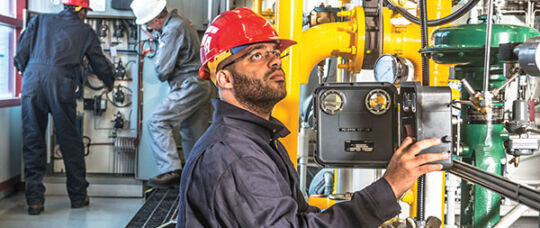How Roar Solutions can Save You Time, Stress, and Money.
How Roar Solutions can Save You Time, Stress, and Money.
Blog Article
Roar Solutions - Truths
Table of ContentsThe 15-Second Trick For Roar SolutionsThe Buzz on Roar SolutionsGet This Report on Roar Solutions
In such an ambience a fire or surge is feasible when three fundamental problems are met. This is commonly referred to as the "dangerous area" or "combustion" triangular. In order to shield installments from a possible surge a technique of evaluating and classifying a potentially hazardous area is required. The purpose of this is to guarantee the right choice and setup of devices to eventually avoid an explosion and to make certain security of life.
(https://www.giantbomb.com/profile/roarsolutions/)
No equipment needs to be mounted where the surface area temperature level of the devices is higher than the ignition temperature level of the provided danger. Below are some usual dirt hazardous and their minimum ignition temperature level. Coal Dust 380C 225C Polythene 420C (melts) Methyl Cellulose 420C 320C Starch 460C 435C Flour 490C 340C Sugar 490C 460C Grain Dust 510C 300C Phenolic Resin 530C > 450C Aluminium 590C > 450C PVC 700C > 450C Soot 810C 570C The chance of the risk being existing in a concentration high enough to trigger an ignition will vary from location to location.
Hazardous area electric tools perhaps developed for usage in higher ambient temperatures. Area Repair By Authorised Personnel: Complex testing may not be required however specific procedures might require to be complied with in order for the devices to preserve its 3rd party ranking. Each item of devices with an unsafe ranking should be examined independently.
Little Known Questions About Roar Solutions.
The devices register is a detailed database of tools records that includes a minimum collection of fields to determine each product's location, technological criteria, Ex category, age, and environmental information. This information is crucial for tracking and taking care of the devices effectively within unsafe areas. On the other hand, for routine or RBI sampling evaluations, the quality will be a combination of Comprehensive and Close assessments. The ratio of Thorough to Close examinations will be determined by the Tools Danger, which is analyzed based on ignition danger (the probability of a source of ignition versus the chance of a flammable atmosphere )and the dangerous location category
( Area 0, 1, or 2). This variation will certainly likewise affect the resourcing demands for job preparation. As soon as Lots are defined, you can create sampling plans based upon the sample size of each Great deal, which refers to the variety of arbitrary tools products to be evaluated. To establish the required example size, 2 elements need to be assessed: the dimension of the Whole lot and the classification of evaluation, which indicates the level of initiative that need to be applied( reduced, typical, or enhanced )to the evaluation of the Whole lot. By incorporating the group of examination with the Whole lot dimension, you can after that develop the appropriate being rejected his comment is here standards for a sample, suggesting the allowable number of damaged products found within that sample. For more details on this process, please refer to the Energy Institute Guidelines. The IEC 60079 standard suggests that the optimum interval in between evaluations ought to not exceed three years. EEHA inspections will also be conducted outside of RBI projects as part of scheduled upkeep and tools overhauls or fixings. These inspections can be attributed towards the RBI sample dimensions within the impacted Lots. EEHA evaluations are performed to determine faults in electrical equipment. A weighted scoring system is important, as a solitary tool might have multiple faults, each with differing levels of ignition risk. If the combined score of both inspections is much less than twice the mistake score, the Lot is regarded appropriate. If the Great deal is still thought about undesirable, it should go through a complete inspection or validation, which might trigger stricter inspection methods. Accepted Whole lot: The sources of any type of faults are recognized. If a common failure mode is discovered, added equipment might need maintenance. Mistakes are categorized by severity( Safety and security, Stability, Home cleaning ), making sure that urgent concerns are examined and resolved quickly to mitigate any kind of influence on security or procedures. The EEHA database need to track and tape-record the lifecycle of faults in addition to the restorative activities taken. Implementing a robust Risk-Based Inspection( RBI )technique is critical for guaranteeing compliance and security in taking care of Electric Equipment in Hazardous Areas( EEHA) (eeha). Automated Mistake Rating and Lifecycle Administration: Easily take care of mistakes and track their lifecycle to boost examination precision. The introduction of this support for risk-based evaluation even more reinforces Inspectivity's placement as a best-in-class solution for regulatory compliance, as well as for any asset-centric assessment usage situation. If you are interested in discovering more, we welcome you to request a presentation and find exactly how our option can change your EEHA management processes.
The 30-Second Trick For Roar Solutions

In terms of eruptive danger, a hazardous location is an atmosphere in which an explosive atmosphere exists (or may be anticipated to be existing) in amounts that call for special preventative measures for the building, installation and use equipment. eeha. In this write-up we check out the challenges faced in the office, the danger control measures, and the needed competencies to function securely
These materials can, in particular problems, create explosive environments and these can have major and tragic repercussions. Many of us are acquainted with the fire triangular get rid of any one of the three aspects and the fire can not happen, however what does this mean in the context of unsafe locations?
In many instances, we can do little concerning the degrees of oxygen in the air, however we can have substantial influence on resources of ignition, for instance electric equipment. Dangerous locations are documented on the unsafe location classification illustration and are recognized on-site by the triangular "EX-SPOUSE" indicator. Below, among various other vital details, areas are split into three types depending on the risk, the possibility and duration that an explosive atmosphere will certainly exist; Area 0 or 20 is regarded one of the most unsafe and Area 2 or 22 is regarded the least.
Report this page